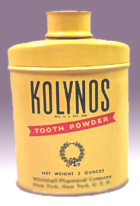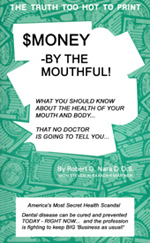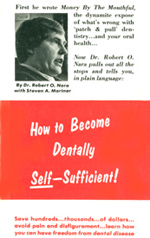| What
Are You Brushing With? Part II |
|
|
Read 'Money by the Mouthful' & 'How to Become Dentally Self Sufficient' by Dr. Robert O. Nara... Learn how to keep your teeth healthy for life... Deal with dental emergencies when you can't get right to the office... Secrets to Saving 'Dental Dollars' And MUCH More... Available
as Ebooks
or Hardcopies
Order Information
---------- OraMedia Home | Articles on Gum Disease | Newsletter Archive | Dr. Robert O. Nara Interview: Freedom From Dental Disease | Healthy Teeth and Gums | 3 Steps to Acheiving Proper Oral Health | Let your Teeth Heal Themselves | How to Eliminate the Dentist From Your Life | Healthy Teeth in Children | FAQ - Frequently Asked Questions | Q&A With a Periodontal Patient | Make Your Own Toothpaste | What Are You Brushing With? (Make your Own Toothpaste Part 2) Subscribe to the OraMedia Newsletter OraMedia Products; Oral Irrigators, Floss, Mouth Rinse, OraMD, Bad Breath and Gingivitis | Is Your Dentist Taking Shortcuts? | How to Become Dentally Self Sufficient Feelings! | Principles of the Seven Factors for Keeping Your Teeth Healthy for Life | Venus, Mars and Oral Hygiene | Via Jet Pro | TheraSol | Glide Floss | OraMD | 10 Tips for Keeping Your Teeth Healthy for Life! | OraMedia Newsletter Advertizing | Take Bad Breath Seriously | Behavioral Effects of Fluorides on Mass Populations | What is the Best Way to Purify My Water? |
Here
are a few comments on the subject of dentifrices.
by Dr. Paul Keyes Why use a dentifrice? (a paste, powder, liquid, or other preparation for cleaning the teeth.) Many years ago, in a terrible decision, the Council on Dental Therapeutic of the ADA said the sole purpose of a dentifrice was to aid in the removal of food particles from tooth surfaces. The council objected to the inclusion of antibacterial agents in toothpastes. At that time (1930s) some manufacturers were adding antibacterial agents to the dentifrices they were producing.  “Kolynos”, for instance,
contained thymol, if my memory serves me, and it was to be used on a
dry brush. In my in vitro testing of the ingredients in this
product when I was at the National Institutes of
Health (NIH), I found that this formulation had a very good
antibacterial potential. In my opinion the advertisements for this
toothpaste were the best I have ever seen. I may still have
some
of the photographs of some of these advertisements that I used to show
when I was giving lectures. After the
council’s ruling the
JADA no longer carried these excellently focused ads for a very good
product for its time. “Kolynos”, for instance,
contained thymol, if my memory serves me, and it was to be used on a
dry brush. In my in vitro testing of the ingredients in this
product when I was at the National Institutes of
Health (NIH), I found that this formulation had a very good
antibacterial potential. In my opinion the advertisements for this
toothpaste were the best I have ever seen. I may still have
some
of the photographs of some of these advertisements that I used to show
when I was giving lectures. After the
council’s ruling the
JADA no longer carried these excellently focused ads for a very good
product for its time.I mention this because the primary dental health benefits attained by using a dentifrice are derived from its potential to do the following: to disorganize, disperse, detoxify, and thereby decontaminate the pathogenic bacterial biofilms that colonize tooth-surfaces and gingival crevices. The mechanical action of brushing, flossing, tooth-picking, mouth-rinsing, and conventional irrigation can reduce bacterial biofilms somewhat, but these methods have no bactericidal action, per se. If a person’s mouth has not been contaminated with pathogenic microorganisms, intensive self-care measures are not necessary. However, since reliable methods for assessing bacterial risk factors in the mouth are not readily available, it seems prudent to use a self-care regimen that has a reliable anti-infective potential. The pathogenic bacteria that colonize one's teeth are acquired largely by the transfer of contaminated saliva from another person’s mouth usually by kissing. Adequate usage of the products listed below will kill many of these microorganisms, if they have been transferred. The secondary benefits are cosmetic: to remove stains from tooth surfaces – to keep tooth surfaces white – pleasing to the eyes. Unfortunately these benefits are the ones most highly advertised. To find a good example of this with audio accompaniment bring up the web site on Kolynos dentifice. Somehow the manufactures got off track. Over the centuries by trying different substances for “tooth-cleaning” people have found some that have made their teeth and gums look and feel better. Some very beneficial combinations have been formulated without any understanding of the therapeutic properties of the ingredients used. In the material that follows I have tried to provide a little insight into the therapeutic potential of some of these substances. Properly used they equal and often surpass the formulations found in many commercial dentifrices. They many not be as tasty or as convenient to use, but they can be far superior therapeutically. Sodium bicarbonate (baking soda), a product used for many years by itself or in combination with other ingredients has several excellent properties. As a soft crystalline substance that dissolves readily, it has a mild abrasive potential. In solution it will kill on contact all of the motile microorganisms associated with periodontal infections, e.g. spirochetes, motile rods, etc. It will also kill other disease related bacteria. It will also neutralize and detoxify the bacterial acids and toxins that form in plaques (bacterial biofilms). I would put this inexpensive, readily available, product at the very top of the list of potentially beneficial dentifrice-ingredients. Sodium chloride (table salt) Like baking soda, salt has been used for many years as a dentifrice, alone or in combination. When used alone it is rather stingy and unless milled, rather grainy. It is not highly abrasive, contrary to some opinions. In solution at higher concentrations it will kill on contact all motile microorganisms associated with periodontal infections. However, its antibacterial potential, while good, is not as powerful as that of sodium bicarbonate, and it will not detoxify bacterial byproducts. In higher concentrations it will reduce edema in the gingival tissues and stimulate circulation. Glycerin Glycerin has an antibacterial potential, which is not well recognized. When living bacterial dental plaque is examined with a phase contrast microscope, all of the motile microorganisms (spirochetes, amoebae, motile rods, tricohmonads, etc) can be seen actively moving about. If a drop of glycerin is add to the solution in which the bacterial are living, all motility instantly ceases. In the scientific literature some of the antibacterial properties of glycerin have been described. Ed. Note: So many readers write to me and tell me that it takes 23 rinses to get rid of glycerin after brushing with it. This is based on non-sense, pseudo-science by Gerald F. Judd, PhD, and a LOT of folks think he wrote the last word about dental care, including a company which makes a popular soap for brushing with (see Keyes on 'soap' below if you want to brush with soap and save $20) and base their product line on his 'scientific' findings. I have responded to this issue here. In fact, yesterday, I decided to brush my own teeth with glycerin to see if what Judd was saying (and what SO many people parrot) was true. I used a common brand of glycerin found in the drug store, loaded my brush and cleaned my teeth for 2 minutes... rinsed once with water and spit. I checked my teeth and they were squeaky clean - you know how you can rub your finger on your teeth and they squeak from being very clean? That was the effect. They weren't greasy or anything from the glycerin. They were clean. Period. I challenge anyone who believes this line of bull from Judd or the soap people to try this experiment for themselves and see. ...then think about what else they are trying to get you to buy into... Hydrogen peroxide. When hydrogen peroxide comes into contact with dentobacterial plaques, it breaks down very rapidly into oxygen and water. This breakdown, which causes the foaming action, is caused by an enzyme (catalase). This foaming action does two things: It helps to disorganize and disperse the bacterial biofilms growing on tooth surfaces, and it reveals places where bacteria are located. When used as an ingredient in dentifrices, it has little, if any, bactericidal action. It breaks down too rapidly. Vinegar Vinegar is another product that has been used for dental hygiene for many years. A half strength solution of vinegar (apple cider for taste) will pickle all of the motile bacteria mentioned above, and it will help to dissolve deposits of calculus. For persons whose dental hygiene does not reduce the buildup of bacterial plaques adequately, some of this buildup may harden into calculus. Brushing several time a week with a vinegar solution can help to prevent calculus formation. Cranberry juice Unsweetened cranberry juice can be used as mouthwash and as a solution for brushing one's teeth. It will kill all motile bacteria on contact and help to disintegrate plaques. Since it is somewhat acidic, probably it should not be used more then a few times a week. It is pleasant to use and can be swallowed. This juice can be used as a rinse and then swallowed. Brushing the teeth with cranberry juice leaves the teeth and mouth feeling very fresh and clean. After brushing one can rinse again and expectorate or swallow the juice. For the care of handicapped persons who cannot manage conventional oral hygiene measures, this could be a pleasant solution for caregivers to use. It is tasty and can be swallowed. Neutrogena Soap (unscented) About 25 years ago a dentist on the West Coast called my attention to the use of unscented Neutrogena soap as an ingredient in a homemade dentifrice. When a solution of this soap comes into contact with the motile microorganisms in plaques all motility ceases rapidly. To use, rub dry or moisten bristles over a bar of this soap. The unscented type tastes soapy. The scented tastes awful. Weak solution of sodium hypochlorite (e.g. Clorox) One teaspoon in a pint of water provides a very powerful irrigation solution (DO NOT INGEST). The taste is very unpleasant, but it can be very beneficial in the maintenance-regimen for persons who have been treated for periodontal diseases. Brushing the teeth with baking soda after using this solution will rapidly neutralize its taste. Then one can rinse with a pleasant tasting mouthwash. There are numerous ways the ingredients mentioned above may be used alone or in combination. With their antibacterial potentials they can be very beneficial therapeutically, if properly applied to tooth surfaces and gingival crevices. They will help to control the bacterial populations that cannot be removed mechanically with irrigation, brushing, flossing, or tooth picking. A very powerful antibacterial combination: Add glycerin to baking soda to form a pasty mixture that can be applied to a toothbrush with a spoon or other instrument.
Regards, Dr. Paul H. Keyes Dr.
Keyes is
the founder of the International Dental Health Foundation
Education: D.D.S., University of Pennsylvania School of Dental Medicine (1941); B.A., University of Rochester (1944); M.S. in Anatomy, University of Rochester (1945); Fellowship in Orthodontics, Harvard University School of Dental Medicine (1948). Research Interests: anti-infective periodontal therapy. Share on Facebook |

